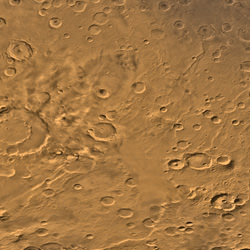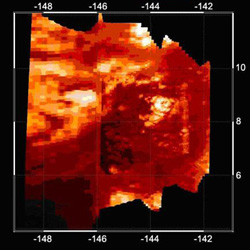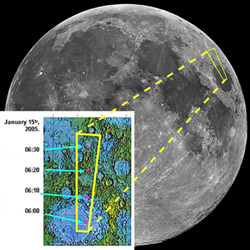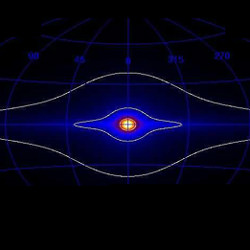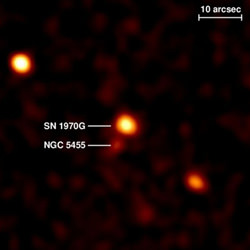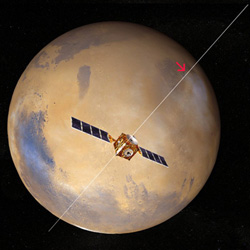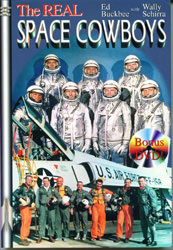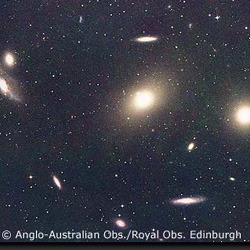
M84/86 Field Credit: David Malin. Click to enlarge.
Monday, June 6 – The Moon becomes New at 21:55 UT. Since our readers enjoy a challenge, there is a very specific galaxy hunt that I have in mind for you tonight. As part of Markarian’s Chain, this set of galaxies can all be fitted within the same field of view with a 32mm eyepiece and a 12.5″ scope. Because not everyone has the same equipment, it became a pet project of mine and co-observer Jeff Barbour to find out just how much of the “Field of Dreams” could be seen in other scopes. So set your sights toward the M84 and M85 and let’s discover!
Good binoculars, a 4.5″ reflector and a 80mm refractor reveals this pair with ease. The two galaxies appear as a matched set of ellipticals. On an exceptional night, a smaller scope will see that there is much more to this region. At 150mm, the western member of the pair – M84 is seen slightly brighter and visibly smaller. East and slightly north is M86. This galaxy’s nucleus is broader, and less intensely brilliant. It appears about one third larger than M84. In a 12.5″ scope, we see the galaxies literally “leap” out of the eyepiece at even the most modest magnifications. Strangely though, additional prominent structure fails to be seen.
Beginning at 6″ and increasing in aperture one of the most fascinating features of this area becomes apparent. While studying the bright galactic forms of the M84/86 with direct vision, aversion begins to welcome many other mysterious strangers into view. Forming an easy triangle with the two Messiers and located about 20 arc-minutes south lies NGC 4388. At magnitude 11.0. this edge-on spiral has dim star-like core to the 150mm, but a classic edge-on structure in larger scopes
At magnitude 12, NGC 4387 is located in the midst of a triangle formed of the two Messiers and NGC 4388. NGC 4387 is a dim galaxy a hint of a stellar nucleus to smaller scopes, while the larger scope sees a very small face-on spiral with a brighter nucleus. About 10 arc-minutes north of M86 is an even dimmer swatch of nebulosity – NGC 4402, which needs higher magnifications to be detected in a smaller scope. Large apertures at high power (300x) reveals a noticeable dust lane. The central structure forms a curved “bar” of light. Luminosity appears evenly distributed end to end, while the dust lane cleanly clips the classic central bulge of the core.
We’ve now gone as “deep” as we can. East of M86 are two brighter NGC galaxies – 4435 and 4438. Through a 6″ scope, NGC 4435 – is easily picked out at low power (50X) with a simple star-like core and wispy round body structure. NGC 4438 is dim, but even at 12.5″ in aperture, elliptical galaxies tend to be rather uninteresting creatures. The beauty of the NGC 4435 and NGC 4438 are simply their proximity to each other. The 4435 shows true elliptical structure, evenly illuminated – with a sense of fading toward the edges… But the 4438 is quite a different story! This elliptical is much more elongated. A highly conspicuous wisp of galactic material can be seen stretching back toward the brighter, nearby galaxy pair M84/86. Happy hunting!
Tuesday, June 7 – Late night SkyWatchers, be alert for the peak of the June Arietid meteor shower during the early morning hours. The radiant is in the constellation of Aries and the fall rate is about 30 per hour. Most are slow moving with some fireballs.
Shortly after sunset, check out the western skyline for a wonderful photographic opportunity. Around 30 to 45 minutes after sunset, you can find bright Venus just above the west-northwest horizon. Scan the area about another fist-width to the planet’s right, and slightly lower for a tender sliver of light. Because the Moon sets a little more than an hour after sunset, timing is critical. Bring your binoculars!
Are you watching Comet 9/P Tempel 1? The time for Deep Impact is getting closer, folks. Still requiring a larger scope, you’ll find the comet around 8 degrees west of Zeta Virginis. Coordinates show a rough position of RA 13:00:71 and Dec +01.02.2. For those with GoTo capabilities, head for NGC 4904 and go north slightly more than a degree.
Wednesday, June 8 – If you haven’t checked on Saturn lately, tonight would be a reason to observe and celebrate. Born on this date in 1625 was Giovanni Cassini – the most notable observer following Galileo. As head of the Paris Observatory for many years, he was the first to observe seasonal changes on Mars and measure its parallax (or distance). This set the scale of the solar system for the first time. Cassini was the first to describe Jovian features, and studied the galiean moons’ orbits. He also discovered four moons of Saturn, but he is best remembered for being the first to see the his namesake division between the A and B rings. Suppose we should name a spacecraft after him?
Tonight the slender Moon will be half a fist-width above Venus. The twilight sky will offer a wonderful opportunity to visualize the ecliptic plane as Saturn appears less than a handspan to the upper left of Selene. If you are out at sunset, look at the point where the Sun disappeared on the horizon with binoculars and you may have a chance to spot Mercury about a fist width to the lower right of Venus. Can you complete the picture by spotting Jupiter as well?
Thursday, June 9 – Today is the birthday of Johann Gottfried Galle. Born in Germany in 1812, Galle was the first observer to locate Neptune. He is also known for being Encke’s assistant – and he’s one of the few astronomers ever to have observed Halley’s Comet twice. Unfortunately, he died two months after the comet passed perihelion in 1910, but at a ripe old age of 98!
Want to practice some astronomy during the day? Then grab an FM radio and enjoy as we are entering some of the strongest daytime radio meteor showers of the year. All you need is an external antenna. Tune the receiver to the lowest frequency that does not produce a clear signal. Each time a meteor passes through our atmosphere, it leaves an ion trail that bounces back distant radio signals to you – even in a stationary car! Listen to the static for a quick rise in volume or a snatch of a distant station that lasts a second or two followed by a fade.
Tonight the more prominent crescent Moon will appear between Castor, Pollux and Saturn. Look for shallow old crater Langrenus just south of central on the limb.
Friday, June 10 – Since next week’s studies will deal mainly with lunar features, let’s try a deep sky object that will show easily despite tonight’s crescent Moon – M13. To help beginner’s recognize the “Keystone” of Hercules, look between bright orange Arcturus overhead and equally bright Vega to the east. You are looking for a lopsided rectangle of stars that are very similar in magnitude and narrow to the south. This “shape” can easily be covered by holding out your closed fist. Look at the top (western-most) two stars – Eta and Zeta – and draw an imaginary line between them. By starting with the northern-most (or top left of the four) move 1/3 the distance along your line and aim your binoculars or telescopes there.
Originally discovered in in 1715, and cataloged in 1764 by Charles Messier, the M13 can only be rivaled by Omega Centauri as the grandest globular cluster in the night sky. This pure population II system contains over 30,000 stars! Enjoy it tonight, and we will return in the weeks ahead to study this incredible object.
Saturday, June 11 – If you haven’t spotted Mercury yet, try again tonight as it climbs toward Venus while Venus moves toward Saturn. Begin watching all three of these planets as a group, because something very cool is about to happen. The trio now covers slightly more than a handspan of sky, but are moving toward a splendid conjunction that will put them about a thumb’s width apart! Mark your calendars now for June 25 and tell your family and friends to watch as the planets dance closer and closer together each night…
Sunday, June 12 – Tonight the Moon very near Regulus, heart of Leo. Can you pick the star out with just your eyes? If you have binoculars, tonight will be your opportunity to spot shallow crater Posidonius along the terminator to the north and the three rings of Theophilus, Cyrillus and Catherina to the south.
If you are out after the Moon sets tonight, keep watch for the peak of the Ophiuchids meteor shower with the radiant near the rising Scorpius. The fall rate is poor with only 3 per hour but fast moving bolides are common. The duration of this meteor stream will last for 25 days.
Even if you have a busy schedule ahead, just watch the movements of the planets as they draw closer over the coming nights. Until next week? Keep your eyes on the skies and may all your journeys be at Light Speed! …~Tammy Plotner
